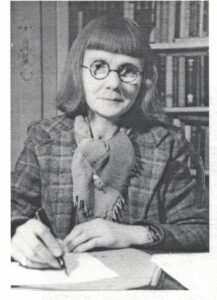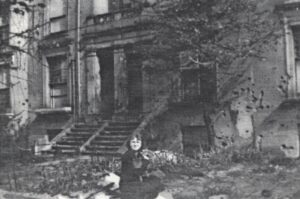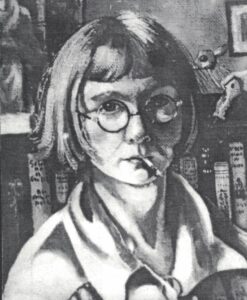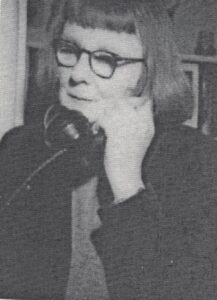08 Jun Caryll Houselander : Finding God in the Blitz
During the summer of 1940, the writer and visual artist Caryll Houselander was going on thirty-nine. Her writing and drawings appeared anonymously in three periodicals: the Jesuit-run Messenger of the Sacred Heart, The Children’s Messenger, and The Grail Magazine. She lived in a house on Milborne Grove with her friend, Iris Wyndham, and Iris’s eighteen-year-old daughter, Joan, who was taking art classes and falling in love with one man after another.
Over the anxious weeks of that uneasy summer there were gin parties with the neighbours and talk of a coming German invasion. There was training at the First Aid post and toy-making and tea parties with the children of refugees who had fled from Nazi-occupied Belgium.
Caryll had spent much of the previous year helping to get the First Aid post in order, putting up with fleas and an infestation of rats in the building, feeling perpetually exhausted and unequal to the nursing task ahead of her. Increasingly, she regarded the wartime afflictions as participation in the Passion of Christ. When war was declared the previous September, she had written to a friend: “I do feel we’ve just got to shut our eyes and dive into this sea of Christ, dive with the trust of people who can’t swim and yet go straight into the dark water.” Shortly afterward, some of her meditative writing appeared in The Grail Magazine under the heading “This War is the Passion.” “Because He has made us ‘other Christs,’” she wrote, “because His life continues in each one of us, there is nothing that any one of us can suffer which is not the Passion He suffered.”
Other meditations followed in further issues of The Grail: “Love” (“the first and last vocation of every Christian….”); “The Kingdom Within” (“we return to the primitive Christianity of the apostles, and having, as Christ had, only ourselves, we require no more….”); “The Flowering of Christ” (“A girl of eleven, asked to teach a child of four to ‘make a sacrifice,’ taught him to make the Sign of the Cross. Asked why this should be a sacrifice, she answered with supreme wisdom, ‘Because for a little minute he gives all of himself to God.’”)
When the air raids started in September, 1940, casualties began to pour into the First Aid post. Less than two months later, Milborne Grove was bombed, and the three found a one-room flat in Nell Gwynne House, where they laid mattresses on the floor.
Caryll wrote to a friend several years later of her terror during the nightly raids on London.

Caryll and her cat, Jones, on Milborne Grove after the bombing of October, 1940
“I tried to build up my courage by reason and prayer, etc., etc. Then one day I realized quite suddenly: as long as I try not to be afraid I shall be worse, and I shall show it one day and break; what God is asking of me to do, for suffering humanity, is to be afraid, to accept it and put up with it.” Asked how she was able to do this, she explained further that she reminded herself of all the other people who were going through the same terrifying experience of destruction and that in the midst of the fear, “I felt that God had put His hand right down through all the well upon well of darkness and horror between Him and me and was holding the central point of my soul; and I knew that however afraid I was then, it would not, even could not, break me.”
Each new insight made its way into the short pieces she wrote for The Grail. The writing was engaging, Caryll’s conversational style dealing directly with the loneliness, grief, and overwhelming feeling of helplessness her readers were living through. Often a short anecdote would lead gently to a profound statement of such breathtaking simplicity that it could have come from the pen of St. Teresa of Avila. Her cat, named Jones, was a favourite subject. Describing an incident in which Jones had sought refuge from a fierce tomcat, she noted how he was then able to relax in her lap. Using the cat’s activity as an example of prayer, she concluded, “There should be, even in the busiest day, a few moments when we can close our eyes and let God possess us.”

An early self-portrait of Caryll
During these months, Maisie Ward, half of the publishing firm Sheed and Ward, was reading the anonymous writer’s meditative pieces in The Grail at her home in the United States. She and her husband, Frank Sheed, decided to seek permission to publish the meditations in a book, and they set about finding out the writer’s identity. Thus began a new chapter in Caryll’s life. Sheed and Ward published This War is the Passion in the United States in 1941 and in Britain the following year. For the first time, Caryll not only saw her name in print, but she also found herself sought after for spiritual advice from readers. The young Jesuit Bernard Lonergan, himself displaced by the war (having been sent from Rome back to his native Canada just days before he was to defend his doctoral dissertation) wrote a review of the book. He noted the author’s “flashes of spiritual insight” and her desire to grow in Christ’s compassion “that not only tries to alleviate suffering but also seeks to share the sufferings of others.”
It is difficult to know exactly how Caryll Houselander came to such spiritual depth. At the time of her birth, her parents’ religion was lacklustre. She was born in Bath two months prematurely, the second of two daughters, and wasn’t expected to survive. As a result, a kitchen bowl was hastily used as a baptismal font, and on the spur of the moment she was named Caryll, after a yacht that her sports-loving mother had recently sailed on. When Caryll was six, her mother had her and her sister, Ruth, received into the Catholic Church, and she herself followed suit some years later. Caryll’s parents divorced when she was eleven. As a result of this rupture to her home life, she was sent to a series of convent boarding schools. Her writing and drawing talents were in evidence during these years, and when she was eighteen she received a scholarship to St. John’s Wood Art School, eventually specializing in woodcuts and wood carving. Through a fellow student she met and fell in love with the dashing spy Sidney Reilly. She was crushed when she learned that Reilly married a wealthy woman in 1923 and died in Russia two years later.
Caryll had fallen away from Catholicism during her art school days, but her diaries for these years indicate an ongoing search. In her autobiography, A Rocking-Horse Catholic, she speaks of a series of psycho-spiritual “experiences” during her early years that seemed to point to the Passion of Jesus, to which she was continually drawn. Along the way she met the Jesuit Geoffrey Bliss, the editor of The Messenger of the Sacred Heart and The Children’s Messenger. Father Bliss recognized her spiritual qualities and hired her to write and make illustrations for his magazines. He remained her spiritual guide until his death in 1952.

Caryll toward the end of her life
Caryll was an enigma to many people. Physically, she remained frail throughout her life. “A funny carroty little thing,” was how a school friend described her, referring to her raggedly cut red hair and small frame. She wore horn-rimmed spectacles and covered her face with a white substance variously described as pastry flour and pancake makeup. A cigarette dangled from her lips as she worked. Joan Wyndham, who had lived with Caryll since childhood, disliked her as a child and, as a young adult, felt afraid of her “penetrating intelligence.” Caryll herself acknowledged her sharp tongue and tendency toward unkind gossip. But as her powerful insights became better known, she was asked to accompany children who had been traumatized by the war.
Caryll continued to write through the food rationing, bomb wreckage and general dislocation of the remaining war years. On V-E Day, May 8, 1945, she, Iris and Joan celebrated the war’s end with a glass of sherry. Later in the day, they brought out a long-hoarded bottle of gin. In the evening, they went off to Trafalgar Square, which was crowded with people dancing, climbing lamp posts and jumping into the fountain. Caryll got tipsy on Pernod, and Joan later wrote that, looking at her, she realized that the woman she’d disliked as a child had mellowed during the war period and that she wasn’t afraid of Caryll any more.
Caryll had nine more years to live. Sheed and Ward continued publishing her books, including Guilt and The Reed of God. During those years, Caryll became the publisher’s top selling author. She died of cancer at the age of 53 on 12 October, 1954.
—published in The Tablet, September 26, 2020


